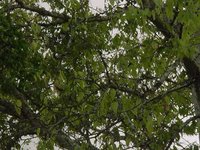
Do hackberry trees grow other places than Texas and the South? If so, do you homeowners with hackberry trees find yourselves drowning in leaves in the fall?
Actually, I don't believe there is a month of the year that the hackberry isn't shedding something.
In the spring, these squiggly yellow pre-leaves come out. They fall. Then the seeds fall. The trees leaf out, but it takes little, like a quick rise in temp or a drop in rain, and the leaves rain down. Berries are produced. They fall when they're soft and make a mess on the soles of your shoes. Fall comes and the leaves yellow and start dropping again. Any remaining berries have turned into rock-hard nuggets. These get stuck in the treads of sneakers and engender a sharp pain in unwary bare feet. I guess winter is about the only time massive amounts of stuff aren't falling from the trees - if you don't count the twigs and small branches that winter storms send down.
In a previous home, some unintelligent person planted a hackberry tree next to a pool. By the time we bought the house, not knowing what the tree had in store for us, the tree was taller than the two-story French provincial. The tree shed into the pool every month of the year, clogging the automatic pool cleaner, the strainer basket, etc. I was thrilled to sell that house for that reason alone.
In my present home, I have two large hackberry trees in the yard. They're far enough from the house that I don't have to contend with their molting. The only one that is a mild nuisance is the one to the side of the driveway because there's always, well, crap from it on the drive, and in the winter bushels of leaves get blown under the porte cochere and pile up around the door. Since the tree also has lace aphids, a common nuisance for hackberry, one dares not park beneath the tree because sap from the tree, filtered through the aphids digestive system and excreted, makes a sticky mess on anything below it.
Arborists considere hackberry trees as attractive, tough, and almost disease-free. I've read that the wood of the hackberry tree is tough, with excellent resistance to breakage (I question that!). Supposedly hackberry wood of good quality is used for furniture, millwork and athletic equipment with lower grade material used for crating. They're supposed to be one of the most eco-friendly trees in North America because the fruit from them (those darn squishy berries which turn into hard nuggets) are relished by wildlife. The way the tree branches is such that nesting birds like them. When decayed, they even hold up well enough for owls and squirrels to move into them. (Gak! Don't get me started on the squirrel problem around here!)
Hackberries come in male and female variety. I think the one in front of my study window is a male because I don't see as much "droppage" from it, or maybe the large curving bed of Asian jasmine that surrounds it conceals its offerings. The one at the side of the driveway must be female - and a drama queen. It weeps all over the place every month of the year.
Here it is November, and I'm drowning in millions of small, thin hackberry leaves. They never seem to stop falling. I can look up at bare branches one day and think the driveway will now be clean. No more leaves tracked into the house. Hurrah! Then the next morning there will be mounds of mystery leaves. I think Mrs. Hackberry goes into secret leaf production each night in order to maintain her constant output.

Even so, I won't remove these trees because they have a saving grace. They do provide the most splendid filtered shade in the warm months - which here in Texas is just about every month.

No comments:
Post a Comment